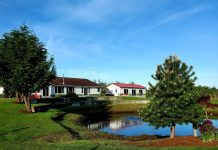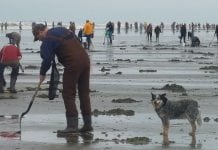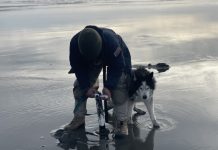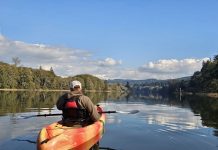This calendar is the place to find fun events happening throughout Grays Harbor County including Aberdeen, Hoquiam, Westport, Ocean Shores, Elma, Montesano and beyond.
Have an event that isn’t listed? Please email events@GraysHarborTalk.com with the following information:
- Name of Event
- Date, time and location (name of business if applicable and complete address)
- Organizer(s) name
- Cost
- URL to purchase tickets
- Website URL
- SHORT description of event
- Photo
Our editors will review and post within a few business days.
First Presbyterian Church of Aberdeen invites you to a FREE Christmas Cantata “By Heaven’s Light” performed by our choir on Sun, Dec 18 at 10 am. 420 N Broadway, Aberdeen, WA 98520.

Heather Osoy is an Aberdeen resident, Women’s Fiction Writers Association member, and homeschool mama.
Come in to learn about and purchase a signed copy of her debut psychological women’s fiction novel, TO HOLD ONESELF.
Already have a copy of her novel? Bring it in to be signed!
Checked it out at the library already? Come in to buy your own signed copy!
?Book Blurb?
On a damp, breezy morning in the spring of 2018, we meet Carol Davis- a charismatic hospice patient. She has a confession to make. That confession leads to a desperate plea, as she wants to redeem herself before time runs out. There is help, but it comes with unwelcome consequences. It becomes apparent that there is more behind the confession… and more to Carol.?Events unfold through the perspectives of a few other women in her life: Lauren, Jamie and Denise. Unbeknownst to those three, they suffer from similar invisible wounds. They also share a conviction that their ability to mend themselves depends on how well they cater to a woman they think they know.

James and Rob Slater grew up here in Hoquiam, HHS classes of ‘78 and ‘85 respectively. Both avid readers, James inspired Rob to write. In 2014, Rob published ALL IS SILENCE, Book I in his Deserted Lands bat-virus pandemic universe. His 5th book is out this winter. James, not to be outdone, has finished his trilogy first, recently releasing Book III, MIDWAY – Empire of Deception. Now they’re working together for success in the challenging arena of indie publishing.
Join us as James and Rob share their experiences and read short excerpts from their books. Q&A and book signing to follow.
WDFW approves final coastal razor clam digs of the spring season beginning Thursday, May 4
OLYMPIA – Washington Department of Fish and Wildlife (WDFW) shellfish managers today confirmed the final coastal razor clam digs of the season can proceed as planned from May 4-14.
“This last tide series had lots of happy diggers, and we’re anticipating more of the same for this upcoming tide series to close out the season,” said Bryce Blumenthal, a WDFW coastal shellfish biologist.
On all open beaches – Long Beach, Twin Harbors, Mocrocks, and Copalis – the daily limit is 20 razor clams instead of the usual 15. Each digger’s clams must be kept in a separate container, and all diggers must keep the first 20 clams they dig, regardless of size or condition.
Not all beaches are open for every dig, so diggers are encouraged to make sure their intended destination is open before heading out. The most successful digging occurs within two hours before the listed time of low tide.
Digging is allowed from midnight until 12 p.m. only on May 4-10. Since low tides on May 11-14 are near or after 12 p.m., digging will be allowed from 4 a.m. until 4 p.m. for those specific days only.
The following digs during morning (a.m.) low tides are scheduled (digging allowed 4 a.m. until 4 p.m. on May 11-14 only):
- May 4, Thursday, 6:32 AM; -0.2 feet; Long Beach, Twin Harbors, Copalis
- May 5, Friday, 7:10 AM; -0.8 feet; Long Beach, Twin Harbors, Mocrocks
- May 6, Saturday, 7:49 AM; -1.2 feet; Long Beach, Twin Harbors, Copalis
- May 7, Sunday, 8:31 AM; -1.4 feet; Long Beach, Twin Harbors, Mocrocks
- May 8, Monday, 9:15 AM; -1.5 feet; Long Beach, Twin Harbors, Copalis
- May 9, Tuesday, 10:03 AM; -1.3 feet; Long Beach, Twin Harbors, Mocrocks
- May 10, Wednesday, 10:57 AM; -1.0 feet; Long Beach, Twin Harbors, Copalis
- May 11, Thursday, 11:56 AM; -0.6 feet; Long Beach, Twin Harbors, Mocrocks (digging allowed 4 AM until 4 PM only)
- May 12, Friday, 12:59 PM; -0.2 feet; Long Beach, Twin Harbors, Copalis (digging allowed 4 AM until 4 PM only)
- May 13, Saturday, 2:03 PM; 0.1 feet; Long Beach, Twin Harbors, Mocrocks (digging allowed 4 AM until 4 PM only)
- May 14, Sunday, 3:03 PM; 0.4 feet; Long Beach, Twin Harbors, Copalis (digging allowed 4 AM until 4 PM only)
WDFW plans to announce tentative digging opportunities in early fall for the 2023-2024 season via the WDFW razor clam webpage. This summer, WDFW will monitor, domoic acid, a natural marine toxin produced by certain types of marine algae, that can be harmful or fatal if consumed in sufficient quantities. More information about domoic acid, as well as current levels at ocean beaches, can be found on WDFW’s domoic acid webpage and on the DOH webpage.
As in past years, WDFW is asking beachgoers to avoid disturbing nesting snowy plovers – a small bird with gray wings and a white breast – by staying out of the dunes and posted areas along the southwest coast. Snowy plover nests are nearly invisible, and it is vital to give birds the space to live and thrive during nesting period, especially along the southern end on Twin Harbors – known as Midway Beach – and the north end of Long Beach.
Avoid leaving leftover food or trash – which attracts predators – on the beach and picnic areas, keep pets on a leash, stay out of dunes, and avoid areas which are clearly marked with posted signs. When driving on the beach, please respect the 25 MPH speed limit and enter only at designated access points. Stay on the hard-packed sand near the high tide line to avoid crushing clam beds and snowy plover nests.
Several sections of coastal beaches are closed to driving between now through Labor Day, except on days and hours when the recreational razor clam digging is open. These areas are clearly marked with signs.
To participate, razor clam diggers must purchase their new 2023-2024 recreational fishing or shellfishing licenses, available from hundreds of license vendors around the state. All diggers age 15 or older must have an applicable fishing license to harvest razor clams on any beach. To be notified of in-season rule changes as they are announced sign up for email notifications at wdfw.wa.gov/about/lists.
The Washington Department of Fish and Wildlife works to preserve, protect, and perpetuate fish, wildlife and ecosystems while providing sustainable fish and wildlife recreational and commercial opportunities.
WDFW approves final coastal razor clam digs of the spring season beginning Thursday, May 4
OLYMPIA – Washington Department of Fish and Wildlife (WDFW) shellfish managers today confirmed the final coastal razor clam digs of the season can proceed as planned from May 4-14.
“This last tide series had lots of happy diggers, and we’re anticipating more of the same for this upcoming tide series to close out the season,” said Bryce Blumenthal, a WDFW coastal shellfish biologist.
On all open beaches – Long Beach, Twin Harbors, Mocrocks, and Copalis – the daily limit is 20 razor clams instead of the usual 15. Each digger’s clams must be kept in a separate container, and all diggers must keep the first 20 clams they dig, regardless of size or condition.
Not all beaches are open for every dig, so diggers are encouraged to make sure their intended destination is open before heading out. The most successful digging occurs within two hours before the listed time of low tide.
Digging is allowed from midnight until 12 p.m. only on May 4-10. Since low tides on May 11-14 are near or after 12 p.m., digging will be allowed from 4 a.m. until 4 p.m. for those specific days only.
The following digs during morning (a.m.) low tides are scheduled (digging allowed 4 a.m. until 4 p.m. on May 11-14 only):
- May 4, Thursday, 6:32 AM; -0.2 feet; Long Beach, Twin Harbors, Copalis
- May 5, Friday, 7:10 AM; -0.8 feet; Long Beach, Twin Harbors, Mocrocks
- May 6, Saturday, 7:49 AM; -1.2 feet; Long Beach, Twin Harbors, Copalis
- May 7, Sunday, 8:31 AM; -1.4 feet; Long Beach, Twin Harbors, Mocrocks
- May 8, Monday, 9:15 AM; -1.5 feet; Long Beach, Twin Harbors, Copalis
- May 9, Tuesday, 10:03 AM; -1.3 feet; Long Beach, Twin Harbors, Mocrocks
- May 10, Wednesday, 10:57 AM; -1.0 feet; Long Beach, Twin Harbors, Copalis
- May 11, Thursday, 11:56 AM; -0.6 feet; Long Beach, Twin Harbors, Mocrocks (digging allowed 4 AM until 4 PM only)
- May 12, Friday, 12:59 PM; -0.2 feet; Long Beach, Twin Harbors, Copalis (digging allowed 4 AM until 4 PM only)
- May 13, Saturday, 2:03 PM; 0.1 feet; Long Beach, Twin Harbors, Mocrocks (digging allowed 4 AM until 4 PM only)
- May 14, Sunday, 3:03 PM; 0.4 feet; Long Beach, Twin Harbors, Copalis (digging allowed 4 AM until 4 PM only)
WDFW plans to announce tentative digging opportunities in early fall for the 2023-2024 season via the WDFW razor clam webpage. This summer, WDFW will monitor, domoic acid, a natural marine toxin produced by certain types of marine algae, that can be harmful or fatal if consumed in sufficient quantities. More information about domoic acid, as well as current levels at ocean beaches, can be found on WDFW’s domoic acid webpage and on the DOH webpage.
As in past years, WDFW is asking beachgoers to avoid disturbing nesting snowy plovers – a small bird with gray wings and a white breast – by staying out of the dunes and posted areas along the southwest coast. Snowy plover nests are nearly invisible, and it is vital to give birds the space to live and thrive during nesting period, especially along the southern end on Twin Harbors – known as Midway Beach – and the north end of Long Beach.
Avoid leaving leftover food or trash – which attracts predators – on the beach and picnic areas, keep pets on a leash, stay out of dunes, and avoid areas which are clearly marked with posted signs. When driving on the beach, please respect the 25 MPH speed limit and enter only at designated access points. Stay on the hard-packed sand near the high tide line to avoid crushing clam beds and snowy plover nests.
Several sections of coastal beaches are closed to driving between now through Labor Day, except on days and hours when the recreational razor clam digging is open. These areas are clearly marked with signs.
To participate, razor clam diggers must purchase their new 2023-2024 recreational fishing or shellfishing licenses, available from hundreds of license vendors around the state. All diggers age 15 or older must have an applicable fishing license to harvest razor clams on any beach. To be notified of in-season rule changes as they are announced sign up for email notifications at wdfw.wa.gov/about/lists.
The Washington Department of Fish and Wildlife works to preserve, protect, and perpetuate fish, wildlife and ecosystems while providing sustainable fish and wildlife recreational and commercial opportunities.
WDFW approves final coastal razor clam digs of the spring season beginning Thursday, May 4
OLYMPIA – Washington Department of Fish and Wildlife (WDFW) shellfish managers today confirmed the final coastal razor clam digs of the season can proceed as planned from May 4-14.
“This last tide series had lots of happy diggers, and we’re anticipating more of the same for this upcoming tide series to close out the season,” said Bryce Blumenthal, a WDFW coastal shellfish biologist.
On all open beaches – Long Beach, Twin Harbors, Mocrocks, and Copalis – the daily limit is 20 razor clams instead of the usual 15. Each digger’s clams must be kept in a separate container, and all diggers must keep the first 20 clams they dig, regardless of size or condition.
Not all beaches are open for every dig, so diggers are encouraged to make sure their intended destination is open before heading out. The most successful digging occurs within two hours before the listed time of low tide.
Digging is allowed from midnight until 12 p.m. only on May 4-10. Since low tides on May 11-14 are near or after 12 p.m., digging will be allowed from 4 a.m. until 4 p.m. for those specific days only.
The following digs during morning (a.m.) low tides are scheduled (digging allowed 4 a.m. until 4 p.m. on May 11-14 only):
- May 4, Thursday, 6:32 AM; -0.2 feet; Long Beach, Twin Harbors, Copalis
- May 5, Friday, 7:10 AM; -0.8 feet; Long Beach, Twin Harbors, Mocrocks
- May 6, Saturday, 7:49 AM; -1.2 feet; Long Beach, Twin Harbors, Copalis
- May 7, Sunday, 8:31 AM; -1.4 feet; Long Beach, Twin Harbors, Mocrocks
- May 8, Monday, 9:15 AM; -1.5 feet; Long Beach, Twin Harbors, Copalis
- May 9, Tuesday, 10:03 AM; -1.3 feet; Long Beach, Twin Harbors, Mocrocks
- May 10, Wednesday, 10:57 AM; -1.0 feet; Long Beach, Twin Harbors, Copalis
- May 11, Thursday, 11:56 AM; -0.6 feet; Long Beach, Twin Harbors, Mocrocks (digging allowed 4 AM until 4 PM only)
- May 12, Friday, 12:59 PM; -0.2 feet; Long Beach, Twin Harbors, Copalis (digging allowed 4 AM until 4 PM only)
- May 13, Saturday, 2:03 PM; 0.1 feet; Long Beach, Twin Harbors, Mocrocks (digging allowed 4 AM until 4 PM only)
- May 14, Sunday, 3:03 PM; 0.4 feet; Long Beach, Twin Harbors, Copalis (digging allowed 4 AM until 4 PM only)
WDFW plans to announce tentative digging opportunities in early fall for the 2023-2024 season via the WDFW razor clam webpage. This summer, WDFW will monitor, domoic acid, a natural marine toxin produced by certain types of marine algae, that can be harmful or fatal if consumed in sufficient quantities. More information about domoic acid, as well as current levels at ocean beaches, can be found on WDFW’s domoic acid webpage and on the DOH webpage.
As in past years, WDFW is asking beachgoers to avoid disturbing nesting snowy plovers – a small bird with gray wings and a white breast – by staying out of the dunes and posted areas along the southwest coast. Snowy plover nests are nearly invisible, and it is vital to give birds the space to live and thrive during nesting period, especially along the southern end on Twin Harbors – known as Midway Beach – and the north end of Long Beach.
Avoid leaving leftover food or trash – which attracts predators – on the beach and picnic areas, keep pets on a leash, stay out of dunes, and avoid areas which are clearly marked with posted signs. When driving on the beach, please respect the 25 MPH speed limit and enter only at designated access points. Stay on the hard-packed sand near the high tide line to avoid crushing clam beds and snowy plover nests.
Several sections of coastal beaches are closed to driving between now through Labor Day, except on days and hours when the recreational razor clam digging is open. These areas are clearly marked with signs.
To participate, razor clam diggers must purchase their new 2023-2024 recreational fishing or shellfishing licenses, available from hundreds of license vendors around the state. All diggers age 15 or older must have an applicable fishing license to harvest razor clams on any beach. To be notified of in-season rule changes as they are announced sign up for email notifications at wdfw.wa.gov/about/lists.
The Washington Department of Fish and Wildlife works to preserve, protect, and perpetuate fish, wildlife and ecosystems while providing sustainable fish and wildlife recreational and commercial opportunities.
WDFW approves final coastal razor clam digs of the spring season beginning Thursday, May 4
OLYMPIA – Washington Department of Fish and Wildlife (WDFW) shellfish managers today confirmed the final coastal razor clam digs of the season can proceed as planned from May 4-14.
“This last tide series had lots of happy diggers, and we’re anticipating more of the same for this upcoming tide series to close out the season,” said Bryce Blumenthal, a WDFW coastal shellfish biologist.
On all open beaches – Long Beach, Twin Harbors, Mocrocks, and Copalis – the daily limit is 20 razor clams instead of the usual 15. Each digger’s clams must be kept in a separate container, and all diggers must keep the first 20 clams they dig, regardless of size or condition.
Not all beaches are open for every dig, so diggers are encouraged to make sure their intended destination is open before heading out. The most successful digging occurs within two hours before the listed time of low tide.
Digging is allowed from midnight until 12 p.m. only on May 4-10. Since low tides on May 11-14 are near or after 12 p.m., digging will be allowed from 4 a.m. until 4 p.m. for those specific days only.
The following digs during morning (a.m.) low tides are scheduled (digging allowed 4 a.m. until 4 p.m. on May 11-14 only):
- May 4, Thursday, 6:32 AM; -0.2 feet; Long Beach, Twin Harbors, Copalis
- May 5, Friday, 7:10 AM; -0.8 feet; Long Beach, Twin Harbors, Mocrocks
- May 6, Saturday, 7:49 AM; -1.2 feet; Long Beach, Twin Harbors, Copalis
- May 7, Sunday, 8:31 AM; -1.4 feet; Long Beach, Twin Harbors, Mocrocks
- May 8, Monday, 9:15 AM; -1.5 feet; Long Beach, Twin Harbors, Copalis
- May 9, Tuesday, 10:03 AM; -1.3 feet; Long Beach, Twin Harbors, Mocrocks
- May 10, Wednesday, 10:57 AM; -1.0 feet; Long Beach, Twin Harbors, Copalis
- May 11, Thursday, 11:56 AM; -0.6 feet; Long Beach, Twin Harbors, Mocrocks (digging allowed 4 AM until 4 PM only)
- May 12, Friday, 12:59 PM; -0.2 feet; Long Beach, Twin Harbors, Copalis (digging allowed 4 AM until 4 PM only)
- May 13, Saturday, 2:03 PM; 0.1 feet; Long Beach, Twin Harbors, Mocrocks (digging allowed 4 AM until 4 PM only)
- May 14, Sunday, 3:03 PM; 0.4 feet; Long Beach, Twin Harbors, Copalis (digging allowed 4 AM until 4 PM only)
WDFW plans to announce tentative digging opportunities in early fall for the 2023-2024 season via the WDFW razor clam webpage. This summer, WDFW will monitor, domoic acid, a natural marine toxin produced by certain types of marine algae, that can be harmful or fatal if consumed in sufficient quantities. More information about domoic acid, as well as current levels at ocean beaches, can be found on WDFW’s domoic acid webpage and on the DOH webpage.
As in past years, WDFW is asking beachgoers to avoid disturbing nesting snowy plovers – a small bird with gray wings and a white breast – by staying out of the dunes and posted areas along the southwest coast. Snowy plover nests are nearly invisible, and it is vital to give birds the space to live and thrive during nesting period, especially along the southern end on Twin Harbors – known as Midway Beach – and the north end of Long Beach.
Avoid leaving leftover food or trash – which attracts predators – on the beach and picnic areas, keep pets on a leash, stay out of dunes, and avoid areas which are clearly marked with posted signs. When driving on the beach, please respect the 25 MPH speed limit and enter only at designated access points. Stay on the hard-packed sand near the high tide line to avoid crushing clam beds and snowy plover nests.
Several sections of coastal beaches are closed to driving between now through Labor Day, except on days and hours when the recreational razor clam digging is open. These areas are clearly marked with signs.
To participate, razor clam diggers must purchase their new 2023-2024 recreational fishing or shellfishing licenses, available from hundreds of license vendors around the state. All diggers age 15 or older must have an applicable fishing license to harvest razor clams on any beach. To be notified of in-season rule changes as they are announced sign up for email notifications at wdfw.wa.gov/about/lists.
The Washington Department of Fish and Wildlife works to preserve, protect, and perpetuate fish, wildlife and ecosystems while providing sustainable fish and wildlife recreational and commercial opportunities.
WDFW approves final coastal razor clam digs of the spring season beginning Thursday, May 4
OLYMPIA – Washington Department of Fish and Wildlife (WDFW) shellfish managers today confirmed the final coastal razor clam digs of the season can proceed as planned from May 4-14.
“This last tide series had lots of happy diggers, and we’re anticipating more of the same for this upcoming tide series to close out the season,” said Bryce Blumenthal, a WDFW coastal shellfish biologist.
On all open beaches – Long Beach, Twin Harbors, Mocrocks, and Copalis – the daily limit is 20 razor clams instead of the usual 15. Each digger’s clams must be kept in a separate container, and all diggers must keep the first 20 clams they dig, regardless of size or condition.
Not all beaches are open for every dig, so diggers are encouraged to make sure their intended destination is open before heading out. The most successful digging occurs within two hours before the listed time of low tide.
Digging is allowed from midnight until 12 p.m. only on May 4-10. Since low tides on May 11-14 are near or after 12 p.m., digging will be allowed from 4 a.m. until 4 p.m. for those specific days only.
The following digs during morning (a.m.) low tides are scheduled (digging allowed 4 a.m. until 4 p.m. on May 11-14 only):
- May 4, Thursday, 6:32 AM; -0.2 feet; Long Beach, Twin Harbors, Copalis
- May 5, Friday, 7:10 AM; -0.8 feet; Long Beach, Twin Harbors, Mocrocks
- May 6, Saturday, 7:49 AM; -1.2 feet; Long Beach, Twin Harbors, Copalis
- May 7, Sunday, 8:31 AM; -1.4 feet; Long Beach, Twin Harbors, Mocrocks
- May 8, Monday, 9:15 AM; -1.5 feet; Long Beach, Twin Harbors, Copalis
- May 9, Tuesday, 10:03 AM; -1.3 feet; Long Beach, Twin Harbors, Mocrocks
- May 10, Wednesday, 10:57 AM; -1.0 feet; Long Beach, Twin Harbors, Copalis
- May 11, Thursday, 11:56 AM; -0.6 feet; Long Beach, Twin Harbors, Mocrocks (digging allowed 4 AM until 4 PM only)
- May 12, Friday, 12:59 PM; -0.2 feet; Long Beach, Twin Harbors, Copalis (digging allowed 4 AM until 4 PM only)
- May 13, Saturday, 2:03 PM; 0.1 feet; Long Beach, Twin Harbors, Mocrocks (digging allowed 4 AM until 4 PM only)
- May 14, Sunday, 3:03 PM; 0.4 feet; Long Beach, Twin Harbors, Copalis (digging allowed 4 AM until 4 PM only)
WDFW plans to announce tentative digging opportunities in early fall for the 2023-2024 season via the WDFW razor clam webpage. This summer, WDFW will monitor, domoic acid, a natural marine toxin produced by certain types of marine algae, that can be harmful or fatal if consumed in sufficient quantities. More information about domoic acid, as well as current levels at ocean beaches, can be found on WDFW’s domoic acid webpage and on the DOH webpage.
As in past years, WDFW is asking beachgoers to avoid disturbing nesting snowy plovers – a small bird with gray wings and a white breast – by staying out of the dunes and posted areas along the southwest coast. Snowy plover nests are nearly invisible, and it is vital to give birds the space to live and thrive during nesting period, especially along the southern end on Twin Harbors – known as Midway Beach – and the north end of Long Beach.
Avoid leaving leftover food or trash – which attracts predators – on the beach and picnic areas, keep pets on a leash, stay out of dunes, and avoid areas which are clearly marked with posted signs. When driving on the beach, please respect the 25 MPH speed limit and enter only at designated access points. Stay on the hard-packed sand near the high tide line to avoid crushing clam beds and snowy plover nests.
Several sections of coastal beaches are closed to driving between now through Labor Day, except on days and hours when the recreational razor clam digging is open. These areas are clearly marked with signs.
To participate, razor clam diggers must purchase their new 2023-2024 recreational fishing or shellfishing licenses, available from hundreds of license vendors around the state. All diggers age 15 or older must have an applicable fishing license to harvest razor clams on any beach. To be notified of in-season rule changes as they are announced sign up for email notifications at wdfw.wa.gov/about/lists.
The Washington Department of Fish and Wildlife works to preserve, protect, and perpetuate fish, wildlife and ecosystems while providing sustainable fish and wildlife recreational and commercial opportunities.
WDFW approves final coastal razor clam digs of the spring season beginning Thursday, May 4
OLYMPIA – Washington Department of Fish and Wildlife (WDFW) shellfish managers today confirmed the final coastal razor clam digs of the season can proceed as planned from May 4-14.
“This last tide series had lots of happy diggers, and we’re anticipating more of the same for this upcoming tide series to close out the season,” said Bryce Blumenthal, a WDFW coastal shellfish biologist.
On all open beaches – Long Beach, Twin Harbors, Mocrocks, and Copalis – the daily limit is 20 razor clams instead of the usual 15. Each digger’s clams must be kept in a separate container, and all diggers must keep the first 20 clams they dig, regardless of size or condition.
Not all beaches are open for every dig, so diggers are encouraged to make sure their intended destination is open before heading out. The most successful digging occurs within two hours before the listed time of low tide.
Digging is allowed from midnight until 12 p.m. only on May 4-10. Since low tides on May 11-14 are near or after 12 p.m., digging will be allowed from 4 a.m. until 4 p.m. for those specific days only.
The following digs during morning (a.m.) low tides are scheduled (digging allowed 4 a.m. until 4 p.m. on May 11-14 only):
- May 4, Thursday, 6:32 AM; -0.2 feet; Long Beach, Twin Harbors, Copalis
- May 5, Friday, 7:10 AM; -0.8 feet; Long Beach, Twin Harbors, Mocrocks
- May 6, Saturday, 7:49 AM; -1.2 feet; Long Beach, Twin Harbors, Copalis
- May 7, Sunday, 8:31 AM; -1.4 feet; Long Beach, Twin Harbors, Mocrocks
- May 8, Monday, 9:15 AM; -1.5 feet; Long Beach, Twin Harbors, Copalis
- May 9, Tuesday, 10:03 AM; -1.3 feet; Long Beach, Twin Harbors, Mocrocks
- May 10, Wednesday, 10:57 AM; -1.0 feet; Long Beach, Twin Harbors, Copalis
- May 11, Thursday, 11:56 AM; -0.6 feet; Long Beach, Twin Harbors, Mocrocks (digging allowed 4 AM until 4 PM only)
- May 12, Friday, 12:59 PM; -0.2 feet; Long Beach, Twin Harbors, Copalis (digging allowed 4 AM until 4 PM only)
- May 13, Saturday, 2:03 PM; 0.1 feet; Long Beach, Twin Harbors, Mocrocks (digging allowed 4 AM until 4 PM only)
- May 14, Sunday, 3:03 PM; 0.4 feet; Long Beach, Twin Harbors, Copalis (digging allowed 4 AM until 4 PM only)
WDFW plans to announce tentative digging opportunities in early fall for the 2023-2024 season via the WDFW razor clam webpage. This summer, WDFW will monitor, domoic acid, a natural marine toxin produced by certain types of marine algae, that can be harmful or fatal if consumed in sufficient quantities. More information about domoic acid, as well as current levels at ocean beaches, can be found on WDFW’s domoic acid webpage and on the DOH webpage.
As in past years, WDFW is asking beachgoers to avoid disturbing nesting snowy plovers – a small bird with gray wings and a white breast – by staying out of the dunes and posted areas along the southwest coast. Snowy plover nests are nearly invisible, and it is vital to give birds the space to live and thrive during nesting period, especially along the southern end on Twin Harbors – known as Midway Beach – and the north end of Long Beach.
Avoid leaving leftover food or trash – which attracts predators – on the beach and picnic areas, keep pets on a leash, stay out of dunes, and avoid areas which are clearly marked with posted signs. When driving on the beach, please respect the 25 MPH speed limit and enter only at designated access points. Stay on the hard-packed sand near the high tide line to avoid crushing clam beds and snowy plover nests.
Several sections of coastal beaches are closed to driving between now through Labor Day, except on days and hours when the recreational razor clam digging is open. These areas are clearly marked with signs.
To participate, razor clam diggers must purchase their new 2023-2024 recreational fishing or shellfishing licenses, available from hundreds of license vendors around the state. All diggers age 15 or older must have an applicable fishing license to harvest razor clams on any beach. To be notified of in-season rule changes as they are announced sign up for email notifications at wdfw.wa.gov/about/lists.
The Washington Department of Fish and Wildlife works to preserve, protect, and perpetuate fish, wildlife and ecosystems while providing sustainable fish and wildlife recreational and commercial opportunities.
WDFW approves final coastal razor clam digs of the spring season beginning Thursday, May 4
OLYMPIA – Washington Department of Fish and Wildlife (WDFW) shellfish managers today confirmed the final coastal razor clam digs of the season can proceed as planned from May 4-14.
“This last tide series had lots of happy diggers, and we’re anticipating more of the same for this upcoming tide series to close out the season,” said Bryce Blumenthal, a WDFW coastal shellfish biologist.
On all open beaches – Long Beach, Twin Harbors, Mocrocks, and Copalis – the daily limit is 20 razor clams instead of the usual 15. Each digger’s clams must be kept in a separate container, and all diggers must keep the first 20 clams they dig, regardless of size or condition.
Not all beaches are open for every dig, so diggers are encouraged to make sure their intended destination is open before heading out. The most successful digging occurs within two hours before the listed time of low tide.
Digging is allowed from midnight until 12 p.m. only on May 4-10. Since low tides on May 11-14 are near or after 12 p.m., digging will be allowed from 4 a.m. until 4 p.m. for those specific days only.
The following digs during morning (a.m.) low tides are scheduled (digging allowed 4 a.m. until 4 p.m. on May 11-14 only):
- May 4, Thursday, 6:32 AM; -0.2 feet; Long Beach, Twin Harbors, Copalis
- May 5, Friday, 7:10 AM; -0.8 feet; Long Beach, Twin Harbors, Mocrocks
- May 6, Saturday, 7:49 AM; -1.2 feet; Long Beach, Twin Harbors, Copalis
- May 7, Sunday, 8:31 AM; -1.4 feet; Long Beach, Twin Harbors, Mocrocks
- May 8, Monday, 9:15 AM; -1.5 feet; Long Beach, Twin Harbors, Copalis
- May 9, Tuesday, 10:03 AM; -1.3 feet; Long Beach, Twin Harbors, Mocrocks
- May 10, Wednesday, 10:57 AM; -1.0 feet; Long Beach, Twin Harbors, Copalis
- May 11, Thursday, 11:56 AM; -0.6 feet; Long Beach, Twin Harbors, Mocrocks (digging allowed 4 AM until 4 PM only)
- May 12, Friday, 12:59 PM; -0.2 feet; Long Beach, Twin Harbors, Copalis (digging allowed 4 AM until 4 PM only)
- May 13, Saturday, 2:03 PM; 0.1 feet; Long Beach, Twin Harbors, Mocrocks (digging allowed 4 AM until 4 PM only)
- May 14, Sunday, 3:03 PM; 0.4 feet; Long Beach, Twin Harbors, Copalis (digging allowed 4 AM until 4 PM only)
WDFW plans to announce tentative digging opportunities in early fall for the 2023-2024 season via the WDFW razor clam webpage. This summer, WDFW will monitor, domoic acid, a natural marine toxin produced by certain types of marine algae, that can be harmful or fatal if consumed in sufficient quantities. More information about domoic acid, as well as current levels at ocean beaches, can be found on WDFW’s domoic acid webpage and on the DOH webpage.
As in past years, WDFW is asking beachgoers to avoid disturbing nesting snowy plovers – a small bird with gray wings and a white breast – by staying out of the dunes and posted areas along the southwest coast. Snowy plover nests are nearly invisible, and it is vital to give birds the space to live and thrive during nesting period, especially along the southern end on Twin Harbors – known as Midway Beach – and the north end of Long Beach.
Avoid leaving leftover food or trash – which attracts predators – on the beach and picnic areas, keep pets on a leash, stay out of dunes, and avoid areas which are clearly marked with posted signs. When driving on the beach, please respect the 25 MPH speed limit and enter only at designated access points. Stay on the hard-packed sand near the high tide line to avoid crushing clam beds and snowy plover nests.
Several sections of coastal beaches are closed to driving between now through Labor Day, except on days and hours when the recreational razor clam digging is open. These areas are clearly marked with signs.
To participate, razor clam diggers must purchase their new 2023-2024 recreational fishing or shellfishing licenses, available from hundreds of license vendors around the state. All diggers age 15 or older must have an applicable fishing license to harvest razor clams on any beach. To be notified of in-season rule changes as they are announced sign up for email notifications at wdfw.wa.gov/about/lists.
The Washington Department of Fish and Wildlife works to preserve, protect, and perpetuate fish, wildlife and ecosystems while providing sustainable fish and wildlife recreational and commercial opportunities.
WDFW approves final coastal razor clam digs of the spring season beginning Thursday, May 4
OLYMPIA – Washington Department of Fish and Wildlife (WDFW) shellfish managers today confirmed the final coastal razor clam digs of the season can proceed as planned from May 4-14.
“This last tide series had lots of happy diggers, and we’re anticipating more of the same for this upcoming tide series to close out the season,” said Bryce Blumenthal, a WDFW coastal shellfish biologist.
On all open beaches – Long Beach, Twin Harbors, Mocrocks, and Copalis – the daily limit is 20 razor clams instead of the usual 15. Each digger’s clams must be kept in a separate container, and all diggers must keep the first 20 clams they dig, regardless of size or condition.
Not all beaches are open for every dig, so diggers are encouraged to make sure their intended destination is open before heading out. The most successful digging occurs within two hours before the listed time of low tide.
Digging is allowed from midnight until 12 p.m. only on May 4-10. Since low tides on May 11-14 are near or after 12 p.m., digging will be allowed from 4 a.m. until 4 p.m. for those specific days only.
The following digs during morning (a.m.) low tides are scheduled (digging allowed 4 a.m. until 4 p.m. on May 11-14 only):
- May 4, Thursday, 6:32 AM; -0.2 feet; Long Beach, Twin Harbors, Copalis
- May 5, Friday, 7:10 AM; -0.8 feet; Long Beach, Twin Harbors, Mocrocks
- May 6, Saturday, 7:49 AM; -1.2 feet; Long Beach, Twin Harbors, Copalis
- May 7, Sunday, 8:31 AM; -1.4 feet; Long Beach, Twin Harbors, Mocrocks
- May 8, Monday, 9:15 AM; -1.5 feet; Long Beach, Twin Harbors, Copalis
- May 9, Tuesday, 10:03 AM; -1.3 feet; Long Beach, Twin Harbors, Mocrocks
- May 10, Wednesday, 10:57 AM; -1.0 feet; Long Beach, Twin Harbors, Copalis
- May 11, Thursday, 11:56 AM; -0.6 feet; Long Beach, Twin Harbors, Mocrocks (digging allowed 4 AM until 4 PM only)
- May 12, Friday, 12:59 PM; -0.2 feet; Long Beach, Twin Harbors, Copalis (digging allowed 4 AM until 4 PM only)
- May 13, Saturday, 2:03 PM; 0.1 feet; Long Beach, Twin Harbors, Mocrocks (digging allowed 4 AM until 4 PM only)
- May 14, Sunday, 3:03 PM; 0.4 feet; Long Beach, Twin Harbors, Copalis (digging allowed 4 AM until 4 PM only)
WDFW plans to announce tentative digging opportunities in early fall for the 2023-2024 season via the WDFW razor clam webpage. This summer, WDFW will monitor, domoic acid, a natural marine toxin produced by certain types of marine algae, that can be harmful or fatal if consumed in sufficient quantities. More information about domoic acid, as well as current levels at ocean beaches, can be found on WDFW’s domoic acid webpage and on the DOH webpage.
As in past years, WDFW is asking beachgoers to avoid disturbing nesting snowy plovers – a small bird with gray wings and a white breast – by staying out of the dunes and posted areas along the southwest coast. Snowy plover nests are nearly invisible, and it is vital to give birds the space to live and thrive during nesting period, especially along the southern end on Twin Harbors – known as Midway Beach – and the north end of Long Beach.
Avoid leaving leftover food or trash – which attracts predators – on the beach and picnic areas, keep pets on a leash, stay out of dunes, and avoid areas which are clearly marked with posted signs. When driving on the beach, please respect the 25 MPH speed limit and enter only at designated access points. Stay on the hard-packed sand near the high tide line to avoid crushing clam beds and snowy plover nests.
Several sections of coastal beaches are closed to driving between now through Labor Day, except on days and hours when the recreational razor clam digging is open. These areas are clearly marked with signs.
To participate, razor clam diggers must purchase their new 2023-2024 recreational fishing or shellfishing licenses, available from hundreds of license vendors around the state. All diggers age 15 or older must have an applicable fishing license to harvest razor clams on any beach. To be notified of in-season rule changes as they are announced sign up for email notifications at wdfw.wa.gov/about/lists.
The Washington Department of Fish and Wildlife works to preserve, protect, and perpetuate fish, wildlife and ecosystems while providing sustainable fish and wildlife recreational and commercial opportunities.
WDFW approves final coastal razor clam digs of the spring season beginning Thursday, May 4
OLYMPIA – Washington Department of Fish and Wildlife (WDFW) shellfish managers today confirmed the final coastal razor clam digs of the season can proceed as planned from May 4-14.
“This last tide series had lots of happy diggers, and we’re anticipating more of the same for this upcoming tide series to close out the season,” said Bryce Blumenthal, a WDFW coastal shellfish biologist.
On all open beaches – Long Beach, Twin Harbors, Mocrocks, and Copalis – the daily limit is 20 razor clams instead of the usual 15. Each digger’s clams must be kept in a separate container, and all diggers must keep the first 20 clams they dig, regardless of size or condition.
Not all beaches are open for every dig, so diggers are encouraged to make sure their intended destination is open before heading out. The most successful digging occurs within two hours before the listed time of low tide.
Digging is allowed from midnight until 12 p.m. only on May 4-10. Since low tides on May 11-14 are near or after 12 p.m., digging will be allowed from 4 a.m. until 4 p.m. for those specific days only.
The following digs during morning (a.m.) low tides are scheduled (digging allowed 4 a.m. until 4 p.m. on May 11-14 only):
- May 4, Thursday, 6:32 AM; -0.2 feet; Long Beach, Twin Harbors, Copalis
- May 5, Friday, 7:10 AM; -0.8 feet; Long Beach, Twin Harbors, Mocrocks
- May 6, Saturday, 7:49 AM; -1.2 feet; Long Beach, Twin Harbors, Copalis
- May 7, Sunday, 8:31 AM; -1.4 feet; Long Beach, Twin Harbors, Mocrocks
- May 8, Monday, 9:15 AM; -1.5 feet; Long Beach, Twin Harbors, Copalis
- May 9, Tuesday, 10:03 AM; -1.3 feet; Long Beach, Twin Harbors, Mocrocks
- May 10, Wednesday, 10:57 AM; -1.0 feet; Long Beach, Twin Harbors, Copalis
- May 11, Thursday, 11:56 AM; -0.6 feet; Long Beach, Twin Harbors, Mocrocks (digging allowed 4 AM until 4 PM only)
- May 12, Friday, 12:59 PM; -0.2 feet; Long Beach, Twin Harbors, Copalis (digging allowed 4 AM until 4 PM only)
- May 13, Saturday, 2:03 PM; 0.1 feet; Long Beach, Twin Harbors, Mocrocks (digging allowed 4 AM until 4 PM only)
- May 14, Sunday, 3:03 PM; 0.4 feet; Long Beach, Twin Harbors, Copalis (digging allowed 4 AM until 4 PM only)
WDFW plans to announce tentative digging opportunities in early fall for the 2023-2024 season via the WDFW razor clam webpage. This summer, WDFW will monitor, domoic acid, a natural marine toxin produced by certain types of marine algae, that can be harmful or fatal if consumed in sufficient quantities. More information about domoic acid, as well as current levels at ocean beaches, can be found on WDFW’s domoic acid webpage and on the DOH webpage.
As in past years, WDFW is asking beachgoers to avoid disturbing nesting snowy plovers – a small bird with gray wings and a white breast – by staying out of the dunes and posted areas along the southwest coast. Snowy plover nests are nearly invisible, and it is vital to give birds the space to live and thrive during nesting period, especially along the southern end on Twin Harbors – known as Midway Beach – and the north end of Long Beach.
Avoid leaving leftover food or trash – which attracts predators – on the beach and picnic areas, keep pets on a leash, stay out of dunes, and avoid areas which are clearly marked with posted signs. When driving on the beach, please respect the 25 MPH speed limit and enter only at designated access points. Stay on the hard-packed sand near the high tide line to avoid crushing clam beds and snowy plover nests.
Several sections of coastal beaches are closed to driving between now through Labor Day, except on days and hours when the recreational razor clam digging is open. These areas are clearly marked with signs.
To participate, razor clam diggers must purchase their new 2023-2024 recreational fishing or shellfishing licenses, available from hundreds of license vendors around the state. All diggers age 15 or older must have an applicable fishing license to harvest razor clams on any beach. To be notified of in-season rule changes as they are announced sign up for email notifications at wdfw.wa.gov/about/lists.
The Washington Department of Fish and Wildlife works to preserve, protect, and perpetuate fish, wildlife and ecosystems while providing sustainable fish and wildlife recreational and commercial opportunities.
WDFW approves final coastal razor clam digs of the spring season beginning Thursday, May 4
OLYMPIA – Washington Department of Fish and Wildlife (WDFW) shellfish managers today confirmed the final coastal razor clam digs of the season can proceed as planned from May 4-14.
“This last tide series had lots of happy diggers, and we’re anticipating more of the same for this upcoming tide series to close out the season,” said Bryce Blumenthal, a WDFW coastal shellfish biologist.
On all open beaches – Long Beach, Twin Harbors, Mocrocks, and Copalis – the daily limit is 20 razor clams instead of the usual 15. Each digger’s clams must be kept in a separate container, and all diggers must keep the first 20 clams they dig, regardless of size or condition.
Not all beaches are open for every dig, so diggers are encouraged to make sure their intended destination is open before heading out. The most successful digging occurs within two hours before the listed time of low tide.
Digging is allowed from midnight until 12 p.m. only on May 4-10. Since low tides on May 11-14 are near or after 12 p.m., digging will be allowed from 4 a.m. until 4 p.m. for those specific days only.
The following digs during morning (a.m.) low tides are scheduled (digging allowed 4 a.m. until 4 p.m. on May 11-14 only):
- May 4, Thursday, 6:32 AM; -0.2 feet; Long Beach, Twin Harbors, Copalis
- May 5, Friday, 7:10 AM; -0.8 feet; Long Beach, Twin Harbors, Mocrocks
- May 6, Saturday, 7:49 AM; -1.2 feet; Long Beach, Twin Harbors, Copalis
- May 7, Sunday, 8:31 AM; -1.4 feet; Long Beach, Twin Harbors, Mocrocks
- May 8, Monday, 9:15 AM; -1.5 feet; Long Beach, Twin Harbors, Copalis
- May 9, Tuesday, 10:03 AM; -1.3 feet; Long Beach, Twin Harbors, Mocrocks
- May 10, Wednesday, 10:57 AM; -1.0 feet; Long Beach, Twin Harbors, Copalis
- May 11, Thursday, 11:56 AM; -0.6 feet; Long Beach, Twin Harbors, Mocrocks (digging allowed 4 AM until 4 PM only)
- May 12, Friday, 12:59 PM; -0.2 feet; Long Beach, Twin Harbors, Copalis (digging allowed 4 AM until 4 PM only)
- May 13, Saturday, 2:03 PM; 0.1 feet; Long Beach, Twin Harbors, Mocrocks (digging allowed 4 AM until 4 PM only)
- May 14, Sunday, 3:03 PM; 0.4 feet; Long Beach, Twin Harbors, Copalis (digging allowed 4 AM until 4 PM only)
WDFW plans to announce tentative digging opportunities in early fall for the 2023-2024 season via the WDFW razor clam webpage. This summer, WDFW will monitor, domoic acid, a natural marine toxin produced by certain types of marine algae, that can be harmful or fatal if consumed in sufficient quantities. More information about domoic acid, as well as current levels at ocean beaches, can be found on WDFW’s domoic acid webpage and on the DOH webpage.
As in past years, WDFW is asking beachgoers to avoid disturbing nesting snowy plovers – a small bird with gray wings and a white breast – by staying out of the dunes and posted areas along the southwest coast. Snowy plover nests are nearly invisible, and it is vital to give birds the space to live and thrive during nesting period, especially along the southern end on Twin Harbors – known as Midway Beach – and the north end of Long Beach.
Avoid leaving leftover food or trash – which attracts predators – on the beach and picnic areas, keep pets on a leash, stay out of dunes, and avoid areas which are clearly marked with posted signs. When driving on the beach, please respect the 25 MPH speed limit and enter only at designated access points. Stay on the hard-packed sand near the high tide line to avoid crushing clam beds and snowy plover nests.
Several sections of coastal beaches are closed to driving between now through Labor Day, except on days and hours when the recreational razor clam digging is open. These areas are clearly marked with signs.
To participate, razor clam diggers must purchase their new 2023-2024 recreational fishing or shellfishing licenses, available from hundreds of license vendors around the state. All diggers age 15 or older must have an applicable fishing license to harvest razor clams on any beach. To be notified of in-season rule changes as they are announced sign up for email notifications at wdfw.wa.gov/about/lists.
The Washington Department of Fish and Wildlife works to preserve, protect, and perpetuate fish, wildlife and ecosystems while providing sustainable fish and wildlife recreational and commercial opportunities.
WDFW approves final coastal razor clam digs of the spring season beginning Thursday, May 4
OLYMPIA – Washington Department of Fish and Wildlife (WDFW) shellfish managers today confirmed the final coastal razor clam digs of the season can proceed as planned from May 4-14.
“This last tide series had lots of happy diggers, and we’re anticipating more of the same for this upcoming tide series to close out the season,” said Bryce Blumenthal, a WDFW coastal shellfish biologist.
On all open beaches – Long Beach, Twin Harbors, Mocrocks, and Copalis – the daily limit is 20 razor clams instead of the usual 15. Each digger’s clams must be kept in a separate container, and all diggers must keep the first 20 clams they dig, regardless of size or condition.
Not all beaches are open for every dig, so diggers are encouraged to make sure their intended destination is open before heading out. The most successful digging occurs within two hours before the listed time of low tide.
Digging is allowed from midnight until 12 p.m. only on May 4-10. Since low tides on May 11-14 are near or after 12 p.m., digging will be allowed from 4 a.m. until 4 p.m. for those specific days only.
The following digs during morning (a.m.) low tides are scheduled (digging allowed 4 a.m. until 4 p.m. on May 11-14 only):
- May 4, Thursday, 6:32 AM; -0.2 feet; Long Beach, Twin Harbors, Copalis
- May 5, Friday, 7:10 AM; -0.8 feet; Long Beach, Twin Harbors, Mocrocks
- May 6, Saturday, 7:49 AM; -1.2 feet; Long Beach, Twin Harbors, Copalis
- May 7, Sunday, 8:31 AM; -1.4 feet; Long Beach, Twin Harbors, Mocrocks
- May 8, Monday, 9:15 AM; -1.5 feet; Long Beach, Twin Harbors, Copalis
- May 9, Tuesday, 10:03 AM; -1.3 feet; Long Beach, Twin Harbors, Mocrocks
- May 10, Wednesday, 10:57 AM; -1.0 feet; Long Beach, Twin Harbors, Copalis
- May 11, Thursday, 11:56 AM; -0.6 feet; Long Beach, Twin Harbors, Mocrocks (digging allowed 4 AM until 4 PM only)
- May 12, Friday, 12:59 PM; -0.2 feet; Long Beach, Twin Harbors, Copalis (digging allowed 4 AM until 4 PM only)
- May 13, Saturday, 2:03 PM; 0.1 feet; Long Beach, Twin Harbors, Mocrocks (digging allowed 4 AM until 4 PM only)
- May 14, Sunday, 3:03 PM; 0.4 feet; Long Beach, Twin Harbors, Copalis (digging allowed 4 AM until 4 PM only)
WDFW plans to announce tentative digging opportunities in early fall for the 2023-2024 season via the WDFW razor clam webpage. This summer, WDFW will monitor, domoic acid, a natural marine toxin produced by certain types of marine algae, that can be harmful or fatal if consumed in sufficient quantities. More information about domoic acid, as well as current levels at ocean beaches, can be found on WDFW’s domoic acid webpage and on the DOH webpage.
As in past years, WDFW is asking beachgoers to avoid disturbing nesting snowy plovers – a small bird with gray wings and a white breast – by staying out of the dunes and posted areas along the southwest coast. Snowy plover nests are nearly invisible, and it is vital to give birds the space to live and thrive during nesting period, especially along the southern end on Twin Harbors – known as Midway Beach – and the north end of Long Beach.
Avoid leaving leftover food or trash – which attracts predators – on the beach and picnic areas, keep pets on a leash, stay out of dunes, and avoid areas which are clearly marked with posted signs. When driving on the beach, please respect the 25 MPH speed limit and enter only at designated access points. Stay on the hard-packed sand near the high tide line to avoid crushing clam beds and snowy plover nests.
Several sections of coastal beaches are closed to driving between now through Labor Day, except on days and hours when the recreational razor clam digging is open. These areas are clearly marked with signs.
To participate, razor clam diggers must purchase their new 2023-2024 recreational fishing or shellfishing licenses, available from hundreds of license vendors around the state. All diggers age 15 or older must have an applicable fishing license to harvest razor clams on any beach. To be notified of in-season rule changes as they are announced sign up for email notifications at wdfw.wa.gov/about/lists.
The Washington Department of Fish and Wildlife works to preserve, protect, and perpetuate fish, wildlife and ecosystems while providing sustainable fish and wildlife recreational and commercial opportunities.
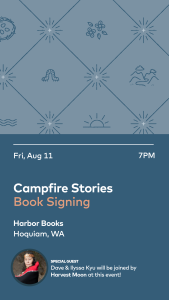
Join us for an indoor camping-themed event at Harbor Books. Curl up with a book in a cozy reading nook, enjoy live music and campfire treats, and meet Dave and Ilyssa Kyu, co-editors of Campfire Stories Volume II: Tales from America’s National Parks and Trails. We will also be joined by contributor Harvest Moon who will do a reading and sign books. Fun for all ages! More information at: https://www.booksontheharbor.com/harbor-books-events/campfirestories
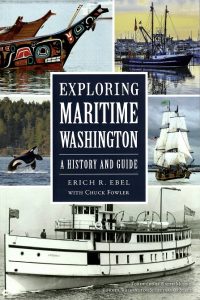
The Museum of the North Beach will be hosting a book signing on Saturday, August 12 from 10am to 12 noon for Exploring Maritime Washington by author Erich Ebel.
Discover the popular destinations and hidden gems along Washington’s coastline, from the Mukilteo Lighthouse to the Wedding Rocks petroglyphs and beyond. Learn about the seafaring Coast Salish people, who navigated the waters of the Pacific Northwest for thousands of years, and the early exploration and settlement by European Americans in the late eighteenth century. Delve into the expansion and growth that led to the development of international ports and the modern maritime economy. View the enormous sternwheel snagboat W.T. Preston—one of a trio that kept inland waterways navigable for nearly a century—and hundreds of other fascinating sites. Join author Erich R. Ebel on a journey through the cultural and nautical history of the Maritime Washington National Heritage Area and beyond.
Erich R. Ebel was born in Spokane, Washington, and has had stories to tell ever since. During his ten years as a TV and radio journalist and twenty in communications and marketing, Erich pursued his passions—the history, heritage and culture of the greatest state in the Lower 48. His blog, videos and podcasts hold a treasure-trove of Washington facts and help promote local history worldwide. Learn more at www.washingtonourhome.com.
Erich spent several hours at the Museum of the North Beach in April 2021 doing research. His 222 page book sells for $24.00 and is loaded with photographs including a segment about the Museum, some of our local history and the amazing story of the 1892 shipwreck of the British bark Ferndale at Copalis Beach.
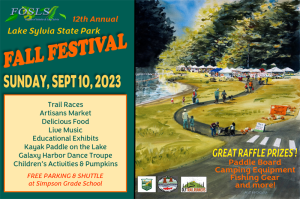
The FOSLS LAKE SYLVIA STATE PARK FALL FESTIVAL continues the tradition for our 12th year!
Come join us on SUNDAY, September 10th, 2023 from 8:30 – 4:00 for a day filled with fun and family activities.
If you enjoy running we have trail Races that begin at 8:30 am. From 10 – 4, you can find one of a kind art and hand crafted treasures at the Artisans Market and eat delicious food while enjoying great live music by talented local acts all on the peaceful shores of beautiful Lake Sylvia. There will also be a kayak paddling adventure, a Watershed Festival by the GH Stream Team, Galaxy Harbor Dancers and educational exhibits in the Legacy Pavilion. You can decorate a pumpkin or take a group photo in our photo booth and we will have kids activities as well.
Park for free at Simpson School (519 Simpson Ave W, Montesano WA), and take a free shuttle to the Festival. Parking inside the park is limited and requires a Discover Pass. Free Disabled Parking is available inside the park. Watch our facebook page at https://www.facebook.com/LakeSylviaStateParkFallFestival for up to date information, applications, and schedules.

Local musicians playing throughout downtown
Preview of Kurt Cobain Tribute Gallery
Gibson Les Paul Guitar drawing for participating musicians
Group “Come As You Are” song by Nirvana
Artist Stage, Bridge Stage, Local Venues, and much more (something for everyone)
Special Appearance from Portlandia “Angel Bouchet” as her blues band
Roger Fisher’s (Heart) The Human Tribe on The Music Project’s Main Stage
The Boni Fide Band featuring Krist Novoselic on The Music Project’s Main Stage
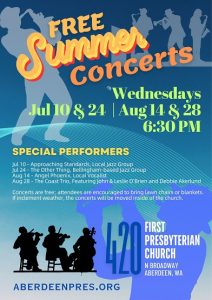
First Presbyterian Church of Aberdeen will hold four concerts this summer as part of our summer lawn concert series. The performances will be held Wednesday, July 10, July 24, August 14, and August 28 at 6:30 PM.
Performers for the series will include:
Jul 10 – Approaching Standards, Local Jazz Group
Jul 24 – The Other Thing, Bellingham-based Jazz Group
Aug 14 – Angel Phoenix, Local Vocalist
Aug 28 – The Coast Trio, Featuring John & Leslie O’Brien and Debbie Akerlund
Concerts are free; attendees are encouraged to bring lawn chairs or blankets. If inclement weather, the concerts will be moved inside of the church.
First Presbyterian Church of Aberdeen is located at 420 N Broadway, Aberdeen, WA 98520. For more info, go to our web site at www.aberdeenpres.org.














